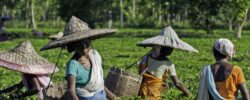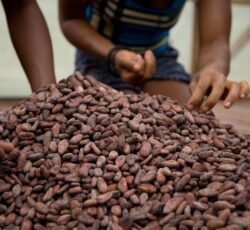The future of coffee with Sander Reuderink from Trabocca
On the 5th of November, Fairfood hosted two panel discussions during the The Only Way is Up! Conference. Impressed with our panellists and the ways they envision the future of food, we conducted some interviews as well – for everyone who couldn’t make it to the conference. Today: Sander Reuderink, commercial director of Trabocca about the future of coffee.
The harvest in the coffee growing regions in the South of Ethiopia has just started. For coffee trader Trabocca it’s this time of the year that its staff is impatiently waiting to learn all about the quality and flavour of the fresh coffee harvest. Despite Trabocca’s experience in the region of more than a decade, this year’s harvest isn’t exactly business as usual; the company is teaming up with Fairfood to make their coffee supply chain transparent. Commercial Director Sander Reuderink explains why.
A batch of approximately 40.000 kilogram of coffee from the Guji region will be blockchained with use of Fairfood’s soon to be launched platform Trace. What’s your motive for that?
“We want to provide irrefutable proof that our farmers were paid what we promise. We will use blockchain to create price transparency all the way up to farm gate. To help our customers make sense of the numbers, we will present them in the context of Trabocca’s contribution to a living income, which is the amount of money the farmers require for a decent standard of living in their region.”
What is Trabocca’s purpose behind this initiative?
“At Trabocca, we’ve always focused on quality and paid our producers a premium for high quality coffee. We brought the first organic and Fairtrade certifiers to Ethiopia. But was that enough? Are producers of high-quality coffee able to earn a living income for their family? A coffee farmer’s income is a function of the price they receive per kilogram, multiplied by their production volume and minus their cost of production. What if we turn that formula around, and use a living income for the farmer as the starting point of the price calculation? As a trial, we selected a group of farmers and used that exact approach to determine the price we pay for their coffee.”
Some of the poorest people in the world are subsidising our coffee.
What drives you to change the coffee sector from the inside?
“I came in touch with the coffee industry through my wife’s family. She’s Jamaican by birth. Her grandfather was a coffee farmer in the Blue Mountains. Even though my own background was in tech, coffee seemed so much more appealing. At first, my dream was to become a farmer, but instead I became a coffee roaster and later a coffee trader. During the last ten years I’ve witnessed too much poverty among coffee farmers. Especially nowadays, with coffee prices at the lowest point in fifteen years in real terms, coffee farmers in most countries are making a loss on every bag of coffee they sell. In other words: some of the poorest people in the world are subsidising our coffee. We need to act now if we want to avoid losing the next generation of coffee farmers.”
Can you explain a bit about the coffee crisis to readers from outside the coffee sector?
“In a nutshell, the price that farmers receive depends on supply and demand. Due to increased production in Brazil, prices have collapsed. Farmers in many countries do not have the option to switch to other products, especially since a coffee tree takes five years to bear fruit, and they might have made long term investments. So, the mechanism of supply and demand is not functioning properly to regulate prices in the coffee sector.”
In coffee it is all about trust. A lot of brands say: ‘Our consumers trust us. They know we pay a good price.’ Why the need for blockchain?
“I disagree with you. I see a lack of trust with consumers. And I don’t disagree with them. Coffee growers produce a semi-finished product. They don’t produce export-ready coffee. In the case of Ethiopia, they produce freshly harvested coffee cherries that are processed by multiple actors along the value chain. Before the coffee reaches the consumer, it goes through so many different hands that there’s no transparency left. Even inside the industry we often do not know exactly what the growers received for their coffee. We do not know if they were able to generate a living income.”
Before the coffee reaches the consumer, it goes through so many different hands that there’s no transparency left.
How do your supply chain partners react to this initiative?
“The local partner we selected for this project is a larger farm that also buys and processes coffee cherries from small-scale coffee farmers that grow their coffee in the same area. He is already paying an above-average price to his outgrowers, but we want to use the traceability platform to generate irrefutable proof that these small-scale farmers are being paid the promised price to contribute to a living income.”
And how do the small-scale farmers adopt the new way of working?
“There are plenty of challenges. One being the lack of technology on the ground. In the farmer group that we’ve selected for the first trial, only one out of three farmers has access to a cell phone. Our original plan was to use mobile payments to capture proof of payment digitally, but it turns out we have to take a low-tech approach for now, asking farmers for fingerprints to verify that they received the payment.”
The coffee will be available from Spring 2020. Will your customers – coffee roasters – also be involved in this initiative?
“We will ask the coffee roasters that buy the coffee from us to pay a small premium for the traceability information. Although all the farmers that participate in this project will be paid the same price, we will sell part of the coffee with access to the transparency tool and part of it without. We want to validate the assumption that customers are willing to pay slightly more for transparent coffee. It’s up to the coffee roasters to determine the sales price they charge their customers – the consumers.”
If we jump a year ahead, where will Trabocca be standing?
“My dream is to end poverty among coffee farmers. For now, I hope to learn from this pilot and use the learnings to improve our pricing-model so we can scale it up to other regions. Can we include agricultural workers in the transparency model? Or can we add a premium for climate effect? There’s so much to do!”


